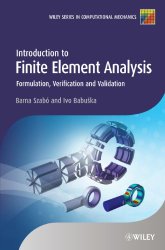Engineering Bookshelf
- Aerospace
- Biological
- Civil
- Chemical
- Environmental
- Electrical
- Materials
- Mechanical
- Petroleum
- Geoengineering
- Software

Introduction to Finite Element Analysis: Formulation, Verification and Validation
by Barna Szabó, Ivo BabukaPublisher: Wiley
ISBN: 0470977280
Check price @ amazon.com , amazon.ca , amazon.co.uk
Book Description
When using numerical simulation to make a decision, how can its reliability be determined? What are the common pitfalls and mistakes when assessing the trustworthiness of computed information, and how can they be avoided?
Whenever numerical simulation is employed in connection with engineering decision-making, there is an implied expectation of reliability: one cannot base decisions on computed information without believing that information is reliable enough to support those decisions. Using mathematical models to show the reliability of computer-generated information is an essential part of any modelling effort.
Giving users of finite element analysis (FEA) software an introduction to verification and validation procedures, this book thoroughly covers the fundamentals of assuring reliability in numerical simulation. The renowned authors systematically guide readers through the basic theory and algorithmic structure of the finite element method, using helpful examples and exercises throughout.
- Delivers the tools needed to have a working knowledge of the finite element method
- Illustrates the concepts and procedures of verification and validation
- Explains the process of conceptualization supported by virtual experimentation
- Describes the convergence characteristics of the h-, p- and hp-methods
- Covers the hierarchic view of mathematical models and finite element spaces
- Uses examples and exercises which illustrate the techniques and procedures of quality assurance
- Ideal for mechanical and structural engineering students, practicing engineers and applied mathematicians
- Includes parameter-controlled examples of solved problems in a companion website (www.wiley.com/go/szabo)
About the Author
Barna Szabó is co-founder and president of Engineering Software Research and Development, Inc. (ESRD), the company that produces the professional finite element analysis software StressCheck®. Prior to his retirement from the School of Engineering and Applied Science of Washington University in 2006 he served as the Albert P. and Blanche Y. Greensfelder Professor of Mechanics. His primary research interest is assurance of quality and reliability in the numerical stimulation of structural and mechanical systems by the finite element method. He has published over 150 papers in refereed technical journals. Several of them in collaboration with Professor Ivo Babuka, with whom he also published a book on finite element analysis (John Wiley & Sons, Inc., 1991). He is a founding member and Fellow of the US Association for Computational Mechanics. Among his honors are election to the Hungarian Academy of Sciences as External Member and an honorary doctorate.
Ivo Babukas research has been concerned mainly with the reliability of computational analysis of mathematical problems and their applications, especially by the finite element method. He was the first to address a posteriori error estimation and adaptivity in finite element analysis. His research papers on these subjects published in the 1970s have been widely cited. His joint work with Barna Szabó on the p-version of the finite element method established the theoretical foundations and the algorithmic structure for this method. His recent work has been concerned with the mathematical formulation and treatment of uncertainties which are present in every mathematical model. In recognition of his numerous important contributions, Professor Babuka received may honors, which include honorary doctorates, medals and prizes and election to prestigious academies.
Customer Reviews
By M. Watkins
From Dr. Barna Szabo, one of the leading FEA expert in the field, and Dr. Ivo Babuska who helped prove the mathematical background, this book provides a solid foundation for anybody interested in using finite element analysis.
It begins with the theoretical background and mathematical formulation of the finite element method, thoroughly explains the process of "verification" and stresses that being able to mathematically prove convergence is extremely important, then goes on to explain element basis functions, high-order geometric mapping, singularities, rates of convergence, and includes practice problems for each topic. This is useful both to learn FEA the first time, and as a reference book when solving real-world problems.
By Jon L. Albee
While Dr. Szabo can't be called one of the p-version "founders," he was a member of the small group of mathematicians who applied FEA to real-world problems in the early 1960s. He is a foremost expert in discretization and idealization of physical models.
This book is a comprehensive treatment of the subject, from theoretical derivation to practical application, with particularly rigorous treatment of discretization and convergence. I was fortunate enough to use a first edition of this book in Dr. Szabo's course at Washington University, when it was something of a work in progress. I'm happy to report that the clarity is much improved in the present volume, which is a critical feature considering the material complexity. The relatively slim book is beautifully printed and bound by Wiley.
The book assumes that the reader has prior exposure and comfort with multivariable calculus and advanced engineering mathematics.